Hammock Camping: The Ultimate Guide
Everything you need to know to get your hammock camping adventures well and truly off the ground!
If you’ve ever enjoyed drifting off to sleeping in a gently rocking hammock, then you will know just how relaxing and peaceful life among the trees can be. Take hammocking to the next level by spending the night camping in a hammock, and a whole new world of camping will be opened up to you. Our guide to hammock camping will take you through everything you need to know to make elevated camping as relaxed, comfortable and enjoyable as sleeping in a good old-fashioned tent – if not more so!
Who is this hammock camping guide for?
- If you’re thinking about jumping into the world of hammock camping but are not sure where to start, this guide is for you.
- If you already own a hammock but have only ever used it to hang out in (and not sleep in over night), this guide is for you.
- If you’ve already given hammock camping a go but want to upgrade your gear, or get a few more tips on how to be a hammock camping pro, this guide is for you.
- Or maybe you just love the outdoors and want to experience it in more ways than you already do. If so, then hammock camping is a great way to get closer to nature and further away from the rest of the world! This guide is most certainly for you.
What will you learn from reading our guide to hammock camping?
The Cool of the Wild ultimate guide to hammock camping will teach you everything you need to know to get your hammock camping adventureswell and truly off the ground. You’ll learn everything about why it’s great, where to do it, how to set up a hammock, and how to sleep in one. There’s advice on the different types of hammocks available, reviews of our top choices of the best camping hammocks around with pros and cons of each, and information on all the extra things you’ll need to successfully spend a night in your hammock. You’ll even learn about the health benefits of sleeping in a hammock, along with some priceless tips from expert hammockers.
How much of this guide should you read?
If you want to really get to grips with hammock camping, and want to come away with a thorough understanding of how to be a hammocking pro, read the lot from start to finish.
Only got a couple of minutes?
The guide is also designed so that you can move around the sections with ease, skipping bits you already know about and re-visiting the parts you need to read over in more detail.
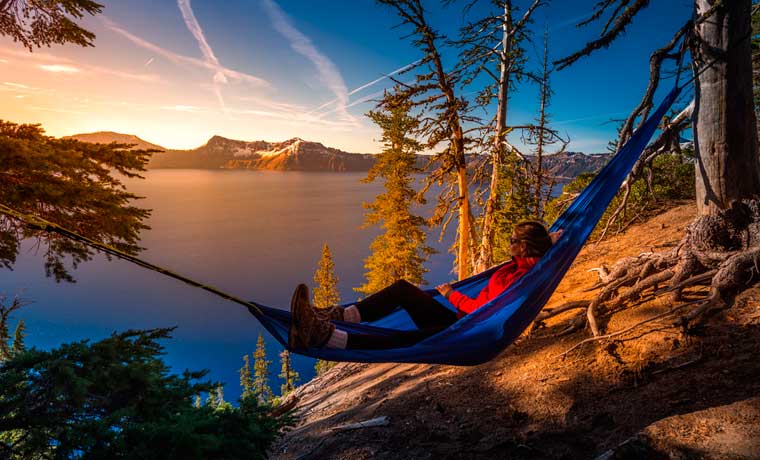
Hammock vs Tent
There are benefits of both. But which is best suited to you?
Most people start their camping capers in a good old fashioned tent and often evolve to hammock camping as and when the need/desire arises. But that’s not to say that if you’re just starting out camping that you shouldn’t jump straight into the world of hammock camping. In fact there are many advantages for camping newbies to get cosy in a hammock instead of a tent: they are inexpensive, simple to use and very comfortable.
But there are also some disadvantages to sleeping in a hammock, whether you are new to camping or not. And of course many of the points raised in the hammock vs tent argument largely depend on where, when and how you are camping. Not to mention personal preference. So let’s take a look at the advantages of both hammock camping and tent camping.
The benefits of hammock camping
If you prefer sleeping wild and getting away from the campgrounds then there are loads of benefits to sleeping in a hammock. But it doesn’t have to be all about roughing it. You can set up your hammock camping site in much the same way as you would with a tent. The presence of a tarp immediately makes things much more suited to bad weather and improves liveability. And what could be better than being rocked to sleep every night?
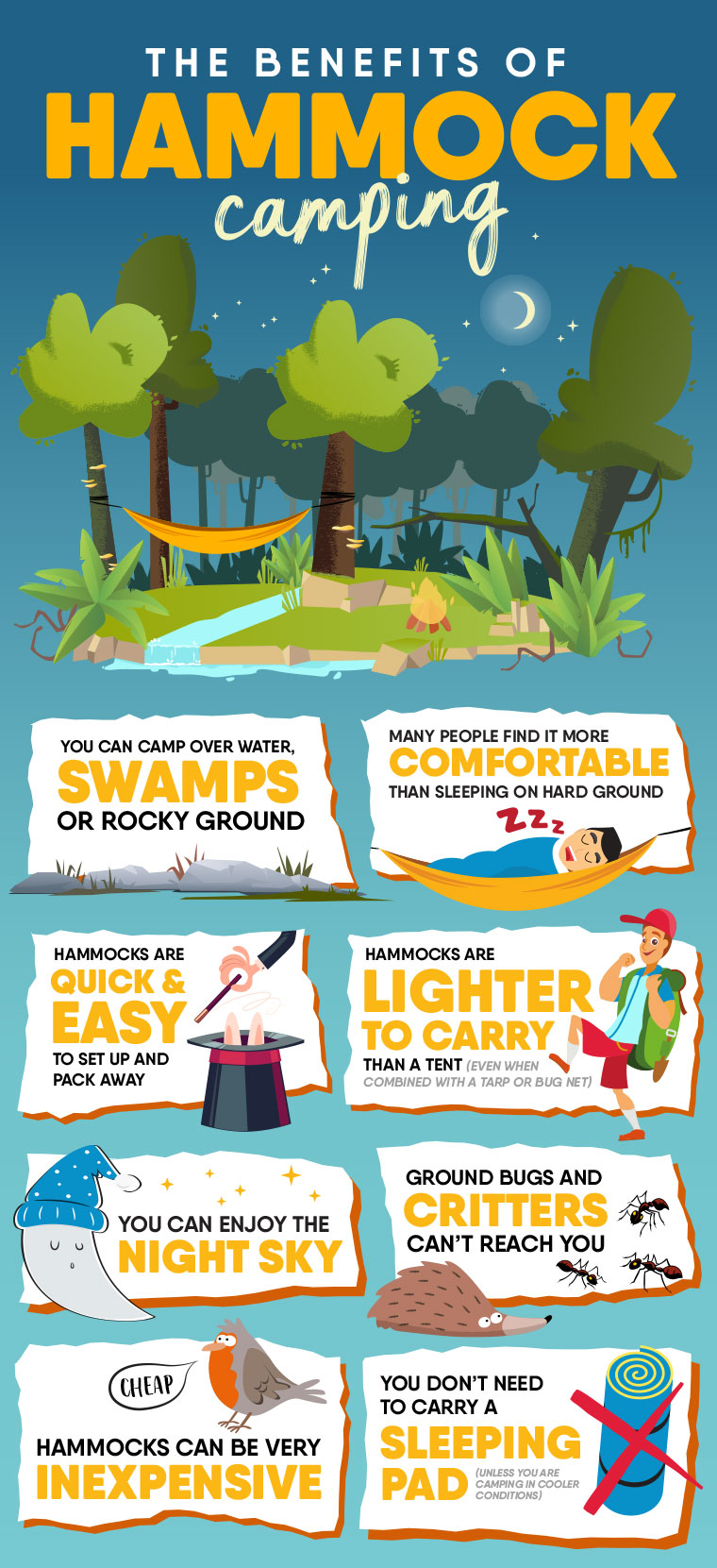
Share this Image On Your Site
Hammock camping is ideal for:
- Fast and light backpackers
- Those who seek sleeping comfort when camping
- Camping in the forest
- Star gazers
- Those who are bored with tent camping!
The benefits of tent camping
For some people, the appeal of camping in a tent comes down to little more than the cosiness that the thin shelter provides, and that reminiscent feeling of den-making as a kid. There’s just something so romantic about sleeping in a tent and listening to the pitter patter of the rain. But on a more practical level, many will argue that you just can’t beat a good old fashioned tent to go camping in.
Here’s why tent camping is great:
- It’s more comfortable to spend time in a tent after dark (but before you want to go to sleep)
- It’s easier to organise all your stuff in a tent
- You are better protected in windy and stormy conditions
- You don’t need to rely on the presence of trees or anchor points
- You can camp above the treeline or in desert and moorland areas
- Some people feel more secure and protected in a tent
- You can easily share a tent with your camping partner or dog, and snuggle up for extra warmth
- Keeping flying bugs out of the tent is relatively easy
- You can zip up the doors and get some privacy if you need it
Camping in a tent is the perfect option for:
- Those looking for sheltered liveable space
- Families or couples
- Those who don’t mind searching around for the perfect camping spot
- Backpacking above the treeline
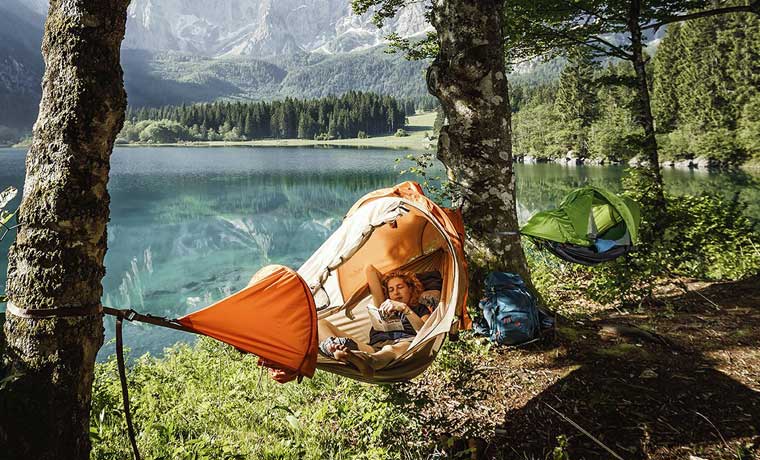
Types of Hammocks
Be sure to hang out in the right one for your hammocking needs
If you’re keen to give hammock camping a go then getting the right setup is essential. There are a few different types of hammocks out there, some of which are ideal for camping and backpacking, and some of which are only really suitable for the backyard.
7 types of hammocks
The main types of hammocks that you are likely to come across are:

Lightweight backpacking hammocks
Ideal for: thru-hikers, bikepackers and adventurers who like to travel light and fast and are willing to sacrifice features and a bit of comfort in order to cut down on grams.
Desirable features: ideally weigh under 1lb (454g), pack small, and are simple to set up and take down.
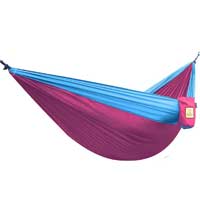
Double hammocks
Ideal for: snugglers and cuddlers who enjoy hanging out together whilst enjoying a spectacular view. Or single sleepers who prefer a little extra wiggle room.
Desirable features: at least 6ft (1.83m) wide and can hold up to 400lb (182kg) in weight.
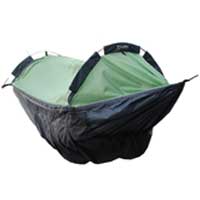
Expedition hammocks
Ideal for: those venturing to places where tented accommodation would be a terrible idea (jungles, forests, swamps, icefields etc).
Desirable features: built-in bug net and double layered bottom for extra warmth if needed.
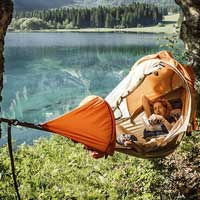
Hammock tents
Ideal for: those who seek versatility and like hammock camping in all conditions and scenarios.
Desirable features: built-in waterproof rainfly and the ability to use as a bivvy, regular tent, or even a poncho! (see the Flying Tent).

Suspended tents
Ideal for: those who like the best of both worlds and like monkeying around in the trees. An excellent way to hammock camp in bad weather.
Desirable features: a waterproof rain fly and a high tension flat-ish base.

String hammocks
Ideal for: relaxing at the beach in the shade of a palm tree, pina colada in hand. Or for backyard lounging.
Desirable features: enough space to hold at least two people and sometimes with spreader bars at each end (as pictured).

Brazilian hammocks
Ideal for: providing more comfort than string hammocks (no diamond patterned skin after laying in one!).
Desirable features: gathered ends, strong, comfortable, and big enough for a small family to hang out in!
To complete your hammock camping setup, you’ll also need a few other extras like a tarp, suspension system and a bug net. Check out Chapter Nine for info on all your hammock camping essentials (and a few non-essentials too!).
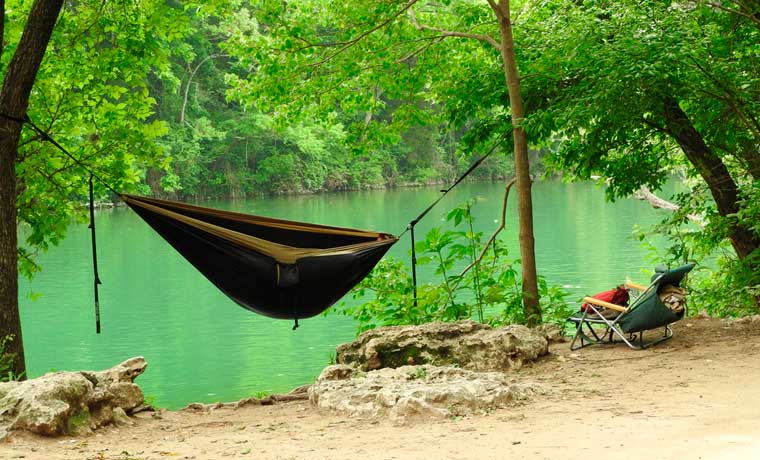
How to Hang a Hammock
It's easy when you know how. We'll guide your through it
Now that you have an idea which of the above types of hammocks might be best suited to you, take a look at what to do with it once you've got it!
How to hang a hammock
Just hang it up and jump in?
Pretty much! Hanging a hammock is so much easier than you may first think. But it’s also very easy to get wrong. Hang it too high and you won’t be able to get in or out of it without the assistance of a precariously balanced stack of logs. Hang it too low, or in trees that are too close together and you might as well just be sleeping on the floor. Hang it between trees that are too far apart and the whole thing will be too stretched to provide any comfort.
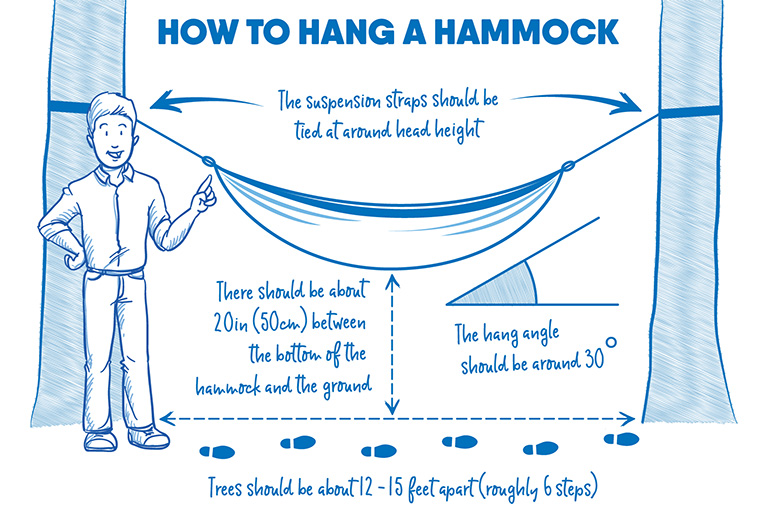
Simple!
It’s not an exact science, and you may find that you prefer there to be more or less sag in the hammock to find that sweet spot for the most comfortable sleeping position. But knowing the basics of how to hang a hammock before you attempt to seek comfort in it will certainly help.
Let’s break it down some more.
A step by step guide on how to hang a hammock
01Choose your anchor points
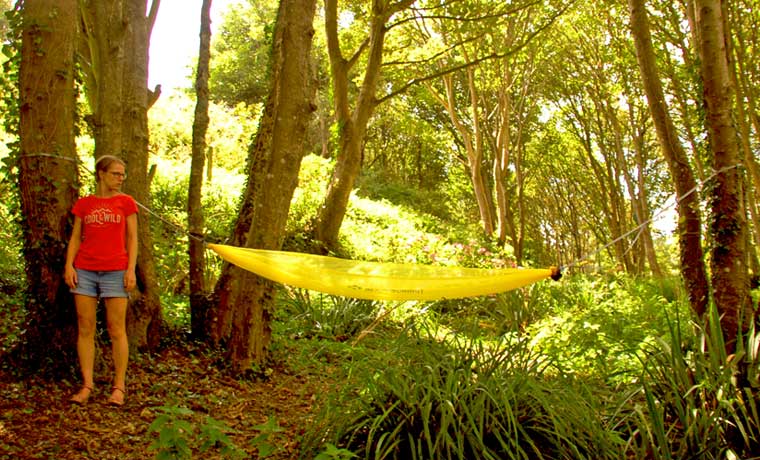
- Around 12-15 feet apart – that’s roughly 6-8 steps
- At least 6in (15cm) in diameter and strong enough to hold the weight of your loaded hammock.
- Free from dead or unstable branches overhead, known as ‘widow-makers’.
Once you’ve hammock camped a couple of times you’ll start looking at all trees and woodland areas as potential hammocking spots. You’ll not see the wilderness in the same way ever again!
02Attach your suspension system to your anchor points
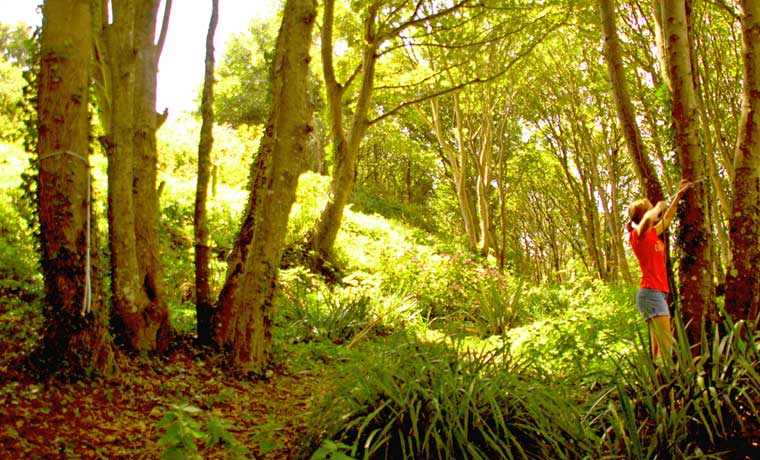
To ensure that you protect the tree you are anchoring to, you will need to use tree straps or a suspension system that is wide enough not to cut into the tree (i.e. not rope or cord). This is mentioned in more detail in the suspension system section in Chapter Nine.
Assuming you have found trees that are roughly the ‘right’ distance apart, you will need to wrap your tree straps around the tree at around head height. Do this on one side, and then the other.
03Attach your hammock to the suspension system
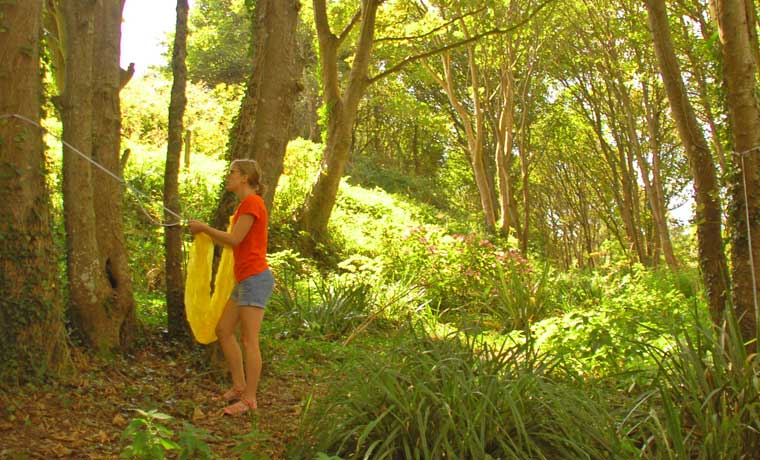
Many hammocks come with their own suspension system and a means to connect it to the hammock. However, if you don’t have a compatible system then you will need to set up your own. There are a variety of ways in which you can do this. But the easiest, and quickest way to attach your suspension system to your hammock is with carabiners – one at each end.
04Adjust your suspension straps

This is the bit that you will need to play with the more you hammock camp. Some hammockers prefer more sag, and others less. So you may want to try out different things as you go. For your first go at hammock camping, however, adjust the suspension straps so that there is roughly a 30º angle between a horizontal plain and the suspension line. See step 7.
05Check the height of the hammock

If you’ve followed all the above steps, then in theory the lowest point of your hammock should end up about 20in (50cm) above the ground. To check this, take a seat in your hammock – your feet should touch the floor comfortably as if you are sitting in a chair. Then lie back, and admire your first hammock hang!
06Try out your sleeping position
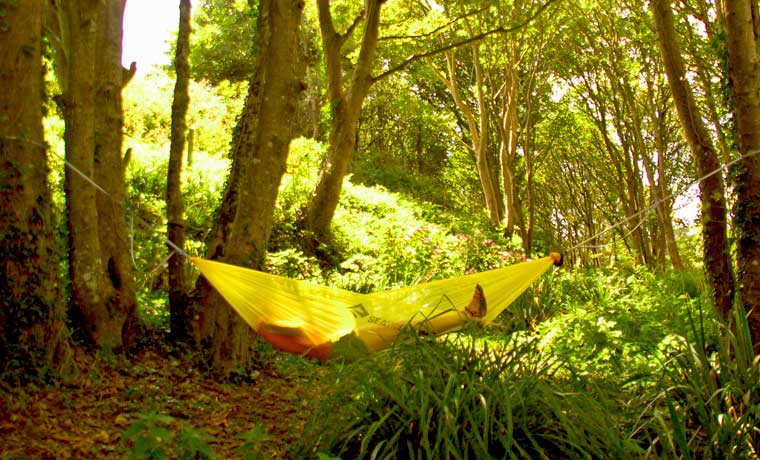
Until you’ve mastered the hammock hang, it’s a good idea to try out your sleeping position before you bed down for the night. That way you can take your time to adjust the hammock to a position that suits you before the sun goes down, and before you get too tired to be bothered to change it. It’s also a great excuse for an afternoon snooze!
07Measure the hang angle

The easiest and simplest way to measure if your hammock hanging is going to be a success or not is to do the quick finger test:
- Make an 'L' shape with your fingers
- Hold your hand out in front of you so that your pointing finger is horizontal (if you are on a slope then don't use the ground as a measure if this!)
- Your thumb should be pointing vertically up to the sky
- The suspension lines should roughly run from the top of your thumb to the end of your pointing finger. This is around a 30º angle.
Use a hammock hang calculator
If you really want to make sure your hammock will hold you securely before you get in it, then use a hammock hang calculator.
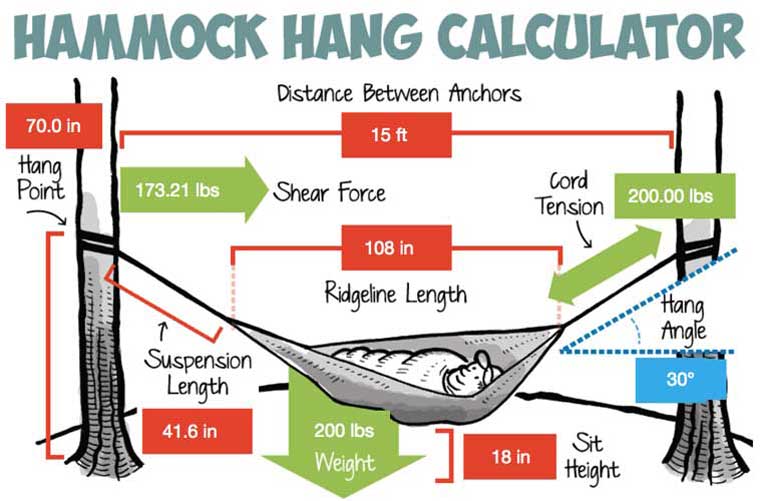
Derek Hansen, hammock camping guru and author of The Ultimate Hang (a book that EVERY hammock camper should read), has created this super simple little tool to help you figure out the best way to hang your hammock. It takes the things you know, like your weight and the distance between your chosen trees, and calculates roughly how high up the trees to attach your hammock suspension system.
Pretty blooming useful!
Where to hang a hammock
Although hanging a hammock between two trees are probably the most common anchor points to choose, there will be times when those perfect trees fail to present themselves, despite your best efforts to find them. Thankfully, the trusty hammock and its super strong suspension system can also be hung in places other than between two trees. And many of these places are great if you've only got one tree available and you just need another anchor point to hang onto.
Other possible hammock anchor points:
- Vehicles
- Goal posts
- Gazebos and pavilions
- Telephone poles
- Between rocks
- Underneath a single horizontal tree branch
Hanging between two trees is a good place to start if you are new to hammock camping. But finding the right trees is one of the hardest parts of hammocking, until you get your eye in!
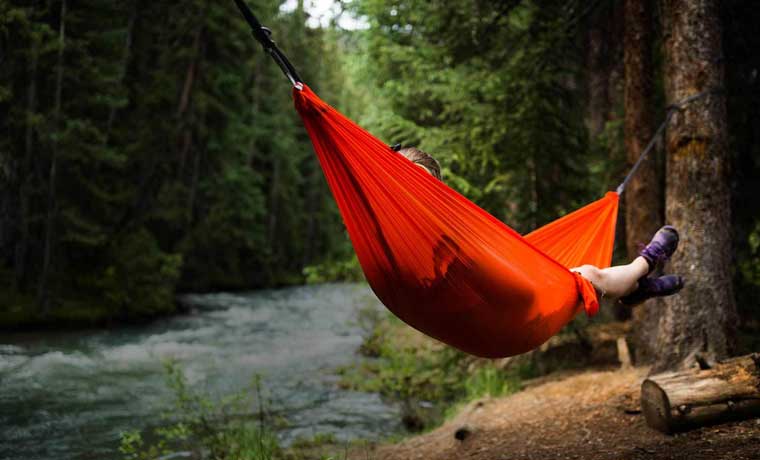
How to Sleep in a Hammock
Get the angles right, kick back and relax in comfort
It’s all very well knowing what all the different types of hammocks there are, and how to hang a hammock, but all that counts for nothing if you don’t know how to sleep in a hammock! Lying in a hammock is one thing, but getting comfortable enough to spend several hours in a suspended cocoon takes a little bit of practice and some inside info!
Brandon at Two Tree Hammock Co insists that:
Hammocking is all about angles, from the initial hanging setup, right down to the position of how you lay inside
He says that "to get the most out of your hang, lay at a slight 30-degree angle across the hammock vs lying directly down the middle. This allows you to create a much flatter surface area and the perfect 'zero pressure' cradle position for you to sleep."
Wise words indeed.
How to sleep in a hammock
Here are a few more tips on how to sleep in a hammock as cosily and comfortably as if it were your bed at home. Well-angled snoozing here we come!:
01Hang your hammock correctly
As mentioned above in Chapter Three, this isn’t the exact science that it’s made out to be, and can take a lot of playing around with to get the right position for you. However, it’s a pretty good place to start. And the simplest way to make sure you’re on the right track is to check the hang angle which should be roughly 30º between the hammock line and horizontal.02Get everything within easy reach
Before you get into your hammock, make sure you have everything you may need close to you. Set your shoes down close by so you don’t have to go searching around for them in the night if nature calls. Some hammocks, like the Warbonnet Blackbird featured in Chapter 7, have gear shelves built-in to the hammock, or you can set up a gear loft to store a book or a headlamp. The ridgeline of your tarp is also really useful to clip things to.03Sleep on the diagonal
Once you’re set up, it’s time to get to grips with how to lay in a hammock. Most people will get into a hammock and lay with their head at one end, their feet at the other, and their body right down the middle. This position is fine for just relaxing in, but sleeping in a hammock requires a much more specific position.
It’s angle time!
Change your position so that your body lays across the midline of the hammock on the diagonal. This is one of the most important things to know to ensure you get the best sleep possible in your suspended cocoon. Spreading your weight across the width of the hammock not only creates a flatter area that is more comfortable for your body to relax on, but also spreads your weight and helps minimise the risk of CBS (Cold Butt Syndrone!).04Put your feet up
Lying with your feet slightly higher than your head is said to be a more comfortable way of sleeping in a hammock as it prevents you from slipping back into the middle. And whilst some hammock brands even recommend that you set up their hammocks with the foot end a little higher than the head end, it ultimately comes down to personal preference. A little experimentation will help you figure out what suits you best in no time.05Bend a knee
If you are a back sleeper then you may find that your knees can become a little uncomfortable due to them hyperextending with the lack of support behind the backs of the knees. If this is the case then you’ll probably adopt another position naturally, but one to try straight away is to bend one of your legs and pop the foot of that leg underneath the knee of the straight leg. Alternatively you can roll up some clothing or a towel and put it under both your knees.06Stay warm in a hammock
In warm conditions, a sleeping bag or quilt will do just fine since you won’t be fighting against the cold ground or air beneath you. But to stay warm in a hammock in cooler conditions, you will need insulation beneath you as well as on top. Using a hammock sleeping pad or underquilt will keep your underside nice and cosy. Read more about these in Chapter Nine

The Health Benefits of Sleeping in a Hammock
From deeper sleep to improved memory. Hang out and get healthy!
Believe it or not, sleeping in a hammock isn’t just for those who have become bored with regular camping. It’s not just reserved for the wanderers out there who prefer to get away from it all. Oh no. There are also some excellent health benefits to sleeping in a hammock that have encouraged some wilderness sleepers to make the move into hanging out in comfort over battling through the night on the hard, cold ground.
The health benefits of sleeping in a hammock
So if you’re tempted to give hammock camping a go but are yet to be convinced, then maybe the health benefits of sleeping in a hammock might just sway you.
More sleep
There’s a reason why babies fall asleep more easily when they are gently rocked. Yes, it’s lovely and relaxing, but studies also show that gentle rocking synchronises brain waves and facilitates the transition from being awake to being asleep. Get cosy in a hammock and you’ll be off to snooze-land faster than usual with more hours of rest ahead of you.Better quality sleep
Not only do swaying hammocks send us off quicker than normal, but once we’re off, the swaying motion also lulls the brain into a deeper than usual sleep. Deep sleep is associated with recovery, so even if our overall sleep time is no longer than normal, the longer we spend in deep sleep (N2 sleep), the more time our bodies are in a nighttime recovery phase of sleep.Reduces stress
The nature of hammocks promotes a sense of escape and calm, and even if you don’t plan on sleeping in one, spending a hour or so gently rocking in comfort is an excellent way to fully relax and unwind. The more relaxed we are, the better we are able to deal with stress when it does come along. So if you’re feeling the tension building, then hang it up and chill out.Good for your back
Sleeping in a hammock is an excellent way to help alleviate pressure points across the body and to realign the vertebrae from your neck right down to the base of your spine. And although there is little solid evidence to back up this claim, there is an abundance of personal accounts stating the improvements they have seen from extended hammock use.Improves brain activity
There are also links between hammock sleeping and improved brain function. The type of brain waves that are stimulated and reinforced through the gentle rocking of a hammock during sleep are also associated with increased concentration and memory. Hanging out really is the smart way to relax!

Hammock Camping Tips
Invaluable advice from the experts. They really know how to hang out in style!
Expert hammock camping tips
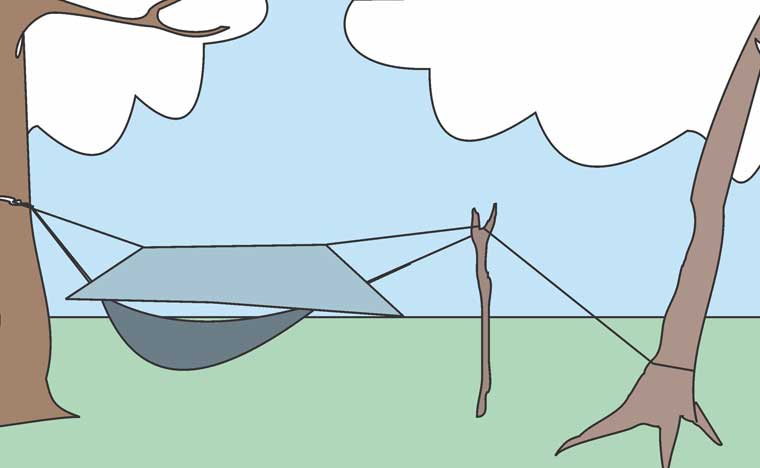
TIP #1: Add a stick if the trees are too far apart
"If trees are too far apart, use Clark's Staff Trick. First tie your hammock to a tree and pull it out towards another support (such as a tree, boulder or stump) that is too far away. Then, find a sturdy branch that is 5.5-7 feet tall and place it where the second tree ought to have been. Wrap your rope around the top of the branch a couple of times and then tie the end down to the base of the second support (you may need to tie on a second length of rope so your rope can make it to the second support). As long as the branch is on solid dirt or grass, and directly in between the two supports, it will sway when you move around in your hammock, but it will not fall."
Clark OutdoorsTIP #2: Beware the Widow Maker!
"You’ve found a couple of trees that are a good distance apart. This looks like the place to hang, right? Not so fast! Check your chosen trees first before hanging your hammock. Don’t hang your hammock on a rotten tree or your weight can pull it down. Also, look up: are there any dead branches above you that could fall? If a good wind could knock the branch down overnight, don’t hang under it. Always hang your hammocks on good, healthy trees."DES from Motorcycle Hammock-Camping
TIP #3: Have fun and relax
"Hammock camping is a rad and easy way to connect with the outdoors and friends. An important part of hammocking is finding the right set of trees to hang your gnar on. But the most important part of hammocking is just to have fun and relax, it's meant to be an easy way to just chill."
Frank from Gnar OutdoorsTIP #4:Insulate your underside
"Don't forget to insulate your underside. Everybody forgets this their first time and ends up cold and shivering at night. Your sleeping bag alone isn't enough because it compresses under your bodyweight and you lose that fluffiness, which is what keeps you warm. In my hammock, I sleep on a blue foam pad because it's cheap and lightweight. Another option is an underquilt, which is a blanket that goes under the hammock, to avoid getting compressed."
Mike Lin at RalltTIP #5: Choose unobstructed views
"Remove barriers between you and nature. Hammock camping creates a next-level experience, integrating you seamlessly with the outdoors. Bonus: fall asleep to the view of shooting stars, rather than the roof of your tent."
KammockTIP #6: Do what works for you
"Hang Your Own Hang (HYOH). In other words: do what works for you. If you are comfortable and enjoying the experience, then stick with it!"
Derek Hansen, author of The Ultimate HangTIP #7: Experiment with hammock camping
"The most important thing when you are getting into hammock camping is to try several different techniques. It's very rare that someone finds their sweet spot on their very first attempt. Versatility is one of the most overlooked benefits of hammock camping. Hang it loose, and then hang it tighter. Keep playing with this. As you change the tightness you'll find it easier to sleep in different positions. At the right tightness, you can sleep comfortably on your side. Try it with a sleeping pad, and then without. I believe that most people who don't prefer hammock camping just haven't experimented with it enough."
Jake at Hobo HammocksTIP #8: Use a hang calculator for your tarp as well as your hammock
"It’s not only your hammock that has to hang correctly between two trees: you’ll need to put up a rain fly for anything but the best weather. There are loads of rain flies that are pretty much mix-and-match with whatever hammock you like. But even a tree-spacing that you can hang your hammock comfortably in might be too short for your fly. Too short a space will mean your fly hangs slack and uneven, and may send streams of rainwater where you don’t want it. One way you can gauge whether the spacing between trees is going to accommodate your fly is to create a “hang calculator,” a simple piece of string that you have measured to fit the length of your fly plus an extra 8” for rigging. Make sure you can recognize the string you use so you won’t mistake it for some random piece of rigging."
NMBL from Motorcycle Hammock-camping

So there you have it. Everything you need to know to get your hammock camping escapades off the ground and in full swing. And just like regular camping, once you’ve got the basics figured out, you’ll never stop learning new tricks of the trade for the rest of your hammock camping days. All that’s left to do is to get out there and get hammocking!


 Hammock vs tent
Hammock vs tent Types of hammocks
Types of hammocks How to hang a hammock
How to hang a hammock Sleeping in a hammock
Sleeping in a hammock The health benefits of sleeping in a hammock
The health benefits of sleeping in a hammock Hammock camping tips
Hammock camping tips Lightweight backpacking hammocks
Lightweight backpacking hammocks Suspended tent and hammock tents
Suspended tent and hammock tents Hammock camping gear and accessories
Hammock camping gear and accessories